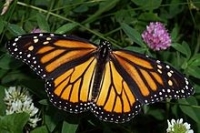


Photo (left): Ivanpah Solar testing; photo by Tom Budlong
Photo (center): warbler with over 50% of its feathers burned was found alive, but died of its injuries
Monarch butterfly (photo, right) numbers are down 90% in the most recent Pacific migration
By Miriam Raftery
April 15, 2014 (San Diego’s East County) – Last month we reported that themonarch butterflies’ annual migration to Mexico is down 90%. Various theories have been proposed. But now a newly released study by the U.S. Fish & Wildlife Service reveals that “hundreds upon hundreds of butterflies” including monarchs, along with dragonflies, were found dead at the Ivanpah solar site.
Some butterflies appeared singed, while others seemed to have fallen from the sky. Careful observation with binoculars showed that the butterflies were congregating near the boiler at the top of the solar tower, apparently attracted by the bright light, as were many other insects.
Birds then flew into the path of destruction, attracted by the insects on which they feed.
KCET published the confidential report, which also chronicles birds burned alive or mortally wounded by the Ivanpah solar project, which the report calls a “megatrap” or artificial feature killing multiple species. Some had also suffered internal hemorrhaging.
A total of 71 bird species (233 total birds killed) were found at three solar sites studied, each of which used different technologies: Genesis , Desert Sunlight, and Ivanpah. Genesis relied on a trough system with parabolic mirrors. Desert Sunlight utilizes photovoltaic solar, while Ivanpah has a power tower which concentrates sunlight using solar flux.
Ivanpah proved by far the deadliest; 141 of the total 233 bird deaths found were at Ivanpah. Only Ivanpah caused death by solar flux (47) due to its unique technology. Desert Sunlight also had a high number of bird deaths (61), mostly from impact trauma and predation – troubling since photovoltaic technology is common. Genesis had 31 bird deaths at its facility, most from undetermined causes.

At Ivanpah, some birds flew into the solar flux and actually ignited. Others, burned and injured seriously, were later devoured by predators on the ground. Still others were killed by impact after flying into the solar equipment. A lake effect of shimmering solar panels may also be attracting migratory birds such as waterfowl.
Morever due to predation and some birds that may have flown farther afield than the study areas at the sites, the authors conclude the true number of deaths is underestimated, “perhaps vastly so.”
The birds killed included migratory songbirds, raptors, ground birds such as roadrunners, waterfowl and more.
The authors propose possible steps to reduce deaths ranging from netting to making equipment less attractive to birds, though it is unknown how effective such steps would or would not be.
No solution, however, has yet been found to the massive butterfly deaths chronicled only at Ivanpah, raising serious concerns about the prospect of any future facilities using the solar flux technology being approved particularly along routes taken by migrating monarch butterflies or birds.








Comments
Such senseless destruction.